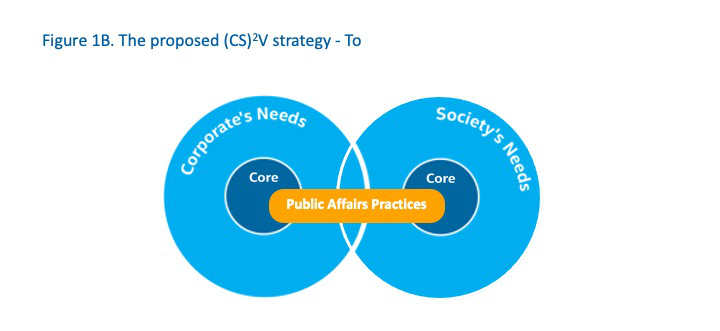Communications of the ACM
The Cross-Sectorial Collaborative Shared Value Strategy

Clockwise from top left, Orit Hazzan, Ronit Lis-Hacohen, Bella Abrahams, and Mariana Waksman.
Credit: Orit Hazzan, Ronit Lis-Hacohen, Bella Abrahams, and Mariana Waksman
This blog proposes a new strategy – cross-sectorial collaborative shared value or (CS)2V for short – that aims to increase the impact of the organization's social investments. The (CS)2V strategy directs corporations to connect the corporation's core business needs, from the corporate perspective, to society's core needs, from the social and/or government perspective. This is done by addressing a social problem that intersects with a business concern. In other words, the corporation can adopt the (CS)2V strategy to fulfill its goals in a more meaningful manner by tightly and clearly connecting the corporation's core business, from the corporate perspective, with a social core need, from the social perspective (see Figure 1). The strategy can be applied, for example, through corporate social responsibility divisions, whose traditional role is to bridge between the corporation and its external environments (i.e., other first-, second- and third-sector organizations).
Figure 1: The (CS)2V Strategy
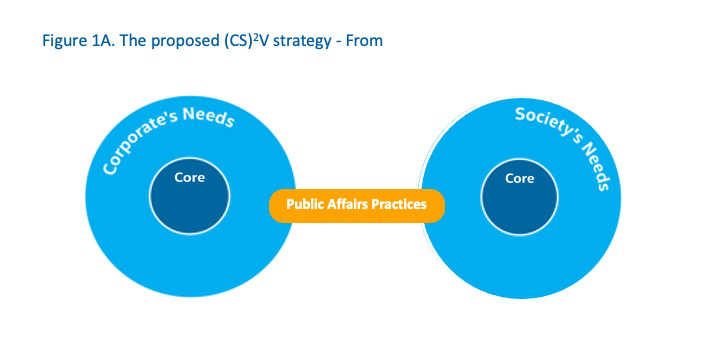
Implementation of the (CS)2V strategy
In general, the (CS)2V strategy guides organizations to be meaningful for their communities and increase their social impact, while improving business results at the same time. It proposes a variation of Porter and Kramer's (2006) perspective on corporate social responsibility by expanding the shared value concept beyond the cooperation between industry and society, to an entire ecosystem that benefits from the collaboration.
The (CS)2V strategy guides organizations in choosing social issues to focus on, by considering five conditions:
1. Unmet social needs that are defined and recognized by the government or authorities;
2. Relatedness to the organization's business values and goals;
3. Possible contribution of added value to the solution of the problem that goes beyond monetary investment;
4. Opportunities to leverage organizational capabilities;
5. Potential partnerships with organizations that bring professionalism to the partnerships and can address missing capabilities.
One of the principles of implementing a cross-sectorial collaboration strategy is the shift from the shared value concept to the collective impact concept. Collective impact occurs when organizations from different sectors agree to solve a specific social problem using a common agenda, aligning their efforts, and using common measures of success (Kania and Kramer, 2011).
This conceptual change, which is based on increasing the number and diversity of the organizations involved,
- expands the social impact (compared with local and limited impact, see Figure 2);
- ensures the sustainability of the collaboration between all organizations, both public and private, and
- benefits more organizations through the collaboration (including first- and third-sector organizations).
Figure 2: Implementation of the (CS)2V Strategy by Shifting from Shared Value to Collective Impact
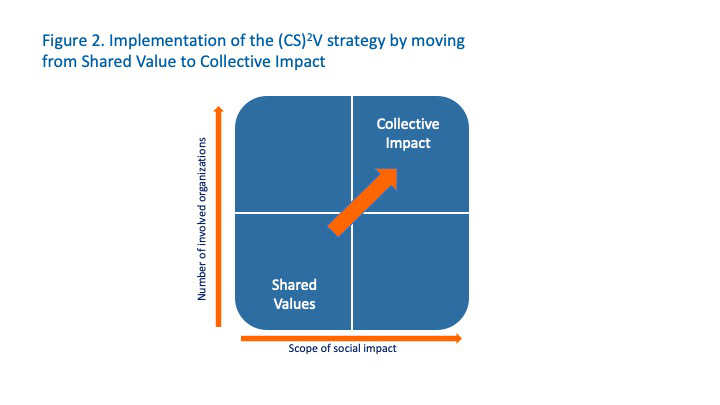
Benefits of the (CS)2V Strategy
In addition to the benefits that society gains from the (CS)2V strategy, the organization and its employees, as well as first- and third-sector organizations, can all gain both direct and indirect core business benefits. From the organization's perspective, different players impart value, since the (CS)2V strategy
- guides organizations of all kinds to allocate budgets for social and philanthropic activities in an alternative and more effective way that amplifies the overall social impact;
- ensures the sustainability of social investments and activities by organically aligning them with the organization's strategy;
- supports the organization in achieving its financial and operational targets by serving a need of society that is strongly related to national imperatives, thus contributes back to the organization;
- shows managers that by collaborating with experts and organizations with different orientations, strengths, and skills, they can improve organizational results from both business and philanthropic perspectives;
- fosters employees' satisfaction and motivation and enables them to implement their professional skills, which, once again, contributes back to the organization;
- positions corporate social responsibility activities within the framework of a structured strategy that is related to that of the organization and, therefore, becomes one of the core elements of the organization's management and its managerial goals.
Implementation of the (CS)2V Strategy: The Case of Intel Israel and STEM Education
Focusing on STEM education, we illustrate how Intel Israel has implemented the (CS)2V strategy in a manner that serves its core business. Acknowledging that reciprocal relations between a business organization and society are beneficial for both parties and create mutual value, Intel is continually searching for creative ways to contribute to the development of the communities around its campuses. Over the years, Intel has realized that random activities, even when they are focused, have a limited impact. Accordingly, leaders at Intel have begun looking for a strategy and model that will make the most of their Company's social investment. In this spirit, we show how Intel played a central role in the implementation of the (CS)2V strategy.
As a significant contributor to Israel's economy, Israel's technology sector depends on large numbers of graduates with high STEM qualifications. The declining numbers of high-school students in STEM subjects was identified in 2011 as posing a major barrier and becoming a major risk to Israel's society and economy (Senor and Singer, 2011). According to the Ministry of Education, the number of school students studying high-level mathematics dropped from almost 13,000 in 2006 to less than 9,000 in 2012. Consequently, the critical importance of investing in STEM education in the whole country was identified and aligned with the Ministry of Education's goals.
The implementation of the (CS)2V strategy led to the foundation of a national coalition (named "5×2" – http://www.5p2.org.il/about-the-5x2-initiative/) that comprises organizations from the hi-tech industry, the academia, and the public and third sectors, each bringing its knowledge, skills, and strengths. All of the participating organizations had expressed similar concerns with respect to the declining numbers of high school students in high-level STEM education. The 5×2 STEM national initiative shifted the partners from a passive to a proactive mode, redirecting some of them to refocus their social investments in accordance with the initiative.
The collaboration yielded, and continues to yield, considerable and meaningful value for all parties, including breakthroughs and proven improvement in related social problems that had been addressed unsuccessfully until then by some of the organizations despite many years of effort. In addition, the coalition partners, who throughout the process build new partnerships, benefit from new fields of knowledge that, in turn, fertilizes both the academic research and the practical work.
Intel's influential position in Israel (in economic, regulatory, and cultural terms) helped it attract organizations from all sectors to the national 5×2 coalition. Multiple programs conceived by the partners of the 5×2 initiative were assessed together with the Ministry of Education and adapted to meet the national plan needs. Concurrently, Intel and its coalition partners helped the Ministry of Education realize the need to raise public awareness of the importance of STEM education using media channels. Increased public awareness started a national discussion on the need to help high school students understand the importance of STEM education for their future career and the choices they will face, as well as the significance of the well-remunerated positions they will fill, both for themselves and for Israel's economy.
The implementation of the (CS)2V strategy has made a measurable impact on math education in Israel. Seven years since the national program began, we are witnessing more than double the number of students studying mathematics at the five-unit level. As a result, and accordingly, an increase is observed in the number of applicants for academic studies in the fields of high tech and science, which will undoubtedly affect the continued economic growth of the State of Israel.
Conclusion
In this blog, we showed how the implementation of the (CS)2V strategy for solving national social problems, enables the organization to benefit from the synchronization between the sectors working together to solve a common national social problem. The quadrants of Figure 3 describe the types of business value that the (CS)2V strategy generates, from a two-dimensional moderate impact to a four-dimensional high impact. As can be seen, from an eco-system perspective, the (CS)2V strategy yields an all-win situation: The collaboration brings high value to all parties, including breakthroughs and proven improvement in coping with the social problems that each of the organizations have been unable to solve on their own for many years.
Figure 3: The (CS)2V Strategy's Impact and Values
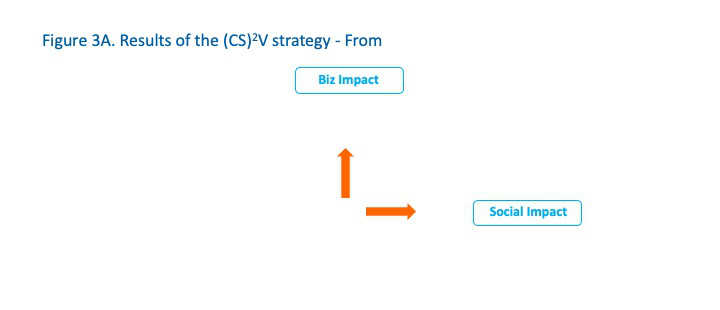
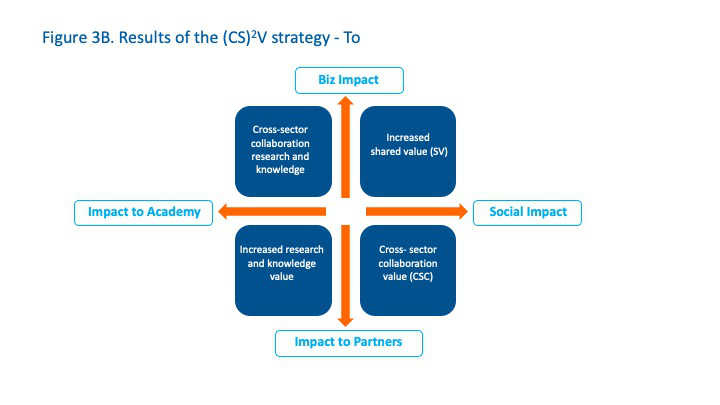
References
Kania, J. and Kramer, M. (Winter 2011). Collective impact, Stanford Social Innovation Review, https://ssir.org/articles/entry/collective_impact#.
Porter, M. and Kramer, M. (December 2006). Strategy & Society: The link between competitive advantage and corporate social responsibility, Harvard Business Review.
Orit Hazzan is a professor at the Technion's Faculty of Education in Science and Technology. Her research focuses on computer science, software engineering and data science education. Bella Abrahams is Corporate and Public Affairs Director at Intel Israel and EMEA, managing Intel's external relations. Mariana Waksman is head of Academic and Education Relations at Intel Israel, responsible for leading strategic partnerships with key decision makers in the Israeli education environment and with Israel's largest universities. Ronit Lis-Hacohen is a Ph.D. student at the Technion’s Faculty of Education in Science and Technology, and Manager of the Technion’s International Office.
No entries found
